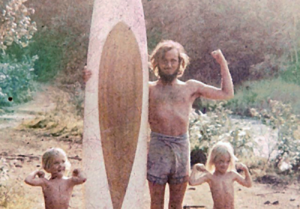The Aquarian Foundation
THE AQUARIAN FOUNDATION TIMELINE
1878 (July 25): Edward Arthur Wilson was born in Birmingham, England.
1912: Wilson claimed to have undergone a “Ceremony of Dedication,” revealing to him that he had “a work to do” of a spiritual nature in the world.
1913–1918: Wilson joined the American Section of the Theosophical Society in Victoria, British Columbia.
1924: Wilson underwent a second ceremony of dedication in southern France, becoming an amanuensis of his Master.
1925 (September): The commencement of “the Work” took place, with the Master dictating The Three Truths to Wilson and informing him of the plans of the Great White Lodge.
1926 (February): The Master gave Wilson the name “Brother XII” and told him that the Work should be known as “The Aquarian Foundation.”
1926 (April): Wilson received “The Invocation of Light,” an important prayer for Aquarian Foundation members.
1927 (February–March): Wilson left England for Canada, arriving in British Columbia, where he purchased property at Cedar-by-the-Sea on Vancouver Island, south of Nanaimo.
1927 (May 16): The Aquarian Foundation was given legal status by the government of British Columbia under the Societies Act.
1928 (January): Wilson attempted to set up a Third Party in the United States by endorsing Senator James Thomas Heflin of Alabama as presidential candidate and by forming the Protestant Protective League to consolidate the anti-Roman Catholic and anti-Jewish sentiment.
1928 (July 5): The Second Annual General Meeting of the Aquarian Foundation took place at Cedar-by-the-Sea.
1928: Valdes Island, where the Mandieh Settlement was later established, was purchased.
1928 (October–December): Wilson was charged with the misappropriation of Aquarian Foundation funds, among other illegalities. He won his court cases.
1929: DeCourcy Island was purchased and the Brothers’ Center was established.
1929 (Spring): Mabel Skottowe arrived from Florida and became Wilson’s mistress, adopting the letter “Z” as her occult name.
1929 (November 15): The Aquarian Foundation was dissolved by the British Columbia government.
1931: Wilson and Mabel Skottowe changed their names to Amiel de Valdes and Zura de Valdes.
1932 (May 15): Abused disciples drafted a “Declaration of Independence,” seeking a meeting with Wilson to discuss conditions at the colony.
1932: Mary Connally and Alfred Barley sued Wilson for the return of their monies, claiming they were the victims of a confidence game
1933 (April): Mary Connally and Alfred Barley won their legal actions. Wilson didn’t appear in court to defend himself, but vandalized the settlements and disappeared to parts unknown.
1933–1934: Wilson returned to England with Mabel Skottowe, living anonymously in Devon. He made a will, leaving all of his assets to her.
1934 (November 7): Edward Arthur Wilson (aka Brother XII, Amiel de Valdes, and Julian Churton Skottowe) died in Neuchâtel, Switzerland.
FOUNDER/GROUP HISTORY
The Aquarian Foundation and its subsequent iteration, the Brothers’ Center, were short-lived millenarian organizations primarily based upon the Theosophical teachings of Helena Petrovna Blavatsky (1831–1891) and secondarily upon selected teachings of Charles Webster Leadbeater (1854–1934) and Annie Besant (1847–1933), the president of the Theosophical Society from 1907 to 1933.
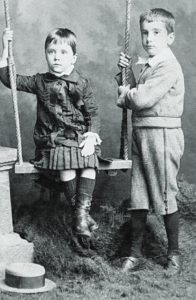
The Aquarian Foundation was established by a self-described Messenger of the Masters (The Brother, XII 2012, “Message”: 2, 5 and 6; Letter II: 13; Letter XIV: 58; Letter XVI: 62) who called himself “Brother XII,” who was born Edward Arthur Wilson in Birmingham, England on July 25, 1878. [Image at right]
In his childhood and early adulthood, Wilson claimed to possess psychic abilities giving him the ability to communicate with “angels,” entities that he later identified as “Masters.” This faculty, together with his early training in astrology and later, his exposure to Theosophical teachings, notably as a member of the Theosophical Society from 1913 to 1918, provided him with the esoteric knowledge to attract a number of wealthy and well-educated individuals to his cause.
By his own account, Wilson passed through a number of initiations, beginning with a “ceremony of dedication,” which was followed by “twelve chaotic years of testing and wandering in all parts of the world” (The Brother, XII 2012, Letter IX:39).
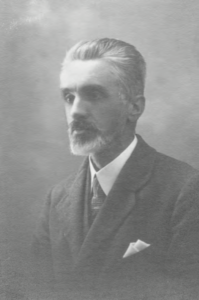
Twelve years later (1924), Wilson underwent a second ceremony of dedication in the south of France that resulted in his attaining a higher consciousness allowing him to become the amanuensis of his Master. The following year, he received material for what eventually would become The Three Truths. Completed by Wilson in February of 1926, this short work contained a summary of the teachings of the Master revealing the “plans of the Hierarchy for the present Work” were completely revealed (The Brother, XII 2012, Letter IX:39). [Image at right]
Wilson, now identified as Brother XII, became the Master’s personal disciple or chela, serving as his intermediary in conducting his “Work” on earth. His immediate goal was aimed at recruiting those who would be receptive to the message in order “to link and to bind” them to work toward similar ends (The Brother, XII 2012, Letter IX:39–40).
The vehicle introduced to reflect the Work of the Masters on the outer planes was identified as “The Aquarian Foundation,” the name given to Wilson by the Master. The Aquarian Foundation was described (The Brother, XII. The End of Days 1928: “What is the Aquarian Foundation?”) as “the pattern and substance of The Great White Lodge Itself.”
The Aquarian Foundation was incorporated as a society in British Columbia, Canada on May 16, 1927. Prior to being granted legal status, a community was already flourishing on a 126-acre piece of waterfront 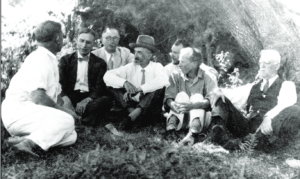 property located at Cedar-by-the Sea in the district of Cedar, a few miles south of Nanaimo on Vancouver Island (Oliphant 1993:200). The Foundation’s purpose was to serve as the location where the souls of the incoming sixth sub-race could incarnate. Shortly after the Foundation’s incorporation, the First Annual General Meeting was held with a governing body of seven Governors present. [Image at right]
property located at Cedar-by-the Sea in the district of Cedar, a few miles south of Nanaimo on Vancouver Island (Oliphant 1993:200). The Foundation’s purpose was to serve as the location where the souls of the incoming sixth sub-race could incarnate. Shortly after the Foundation’s incorporation, the First Annual General Meeting was held with a governing body of seven Governors present. [Image at right]
Wilson claimed that the confraternity of Masters, the Great White Lodge, consisted of twelve groups specifically concerned with the evolution of humanity, with the work of the Aquarian Foundation being especially an expression of the Third, Ninth and Twelfth Houses (The Brother, XII 2012, Letter XVI:64–66). Wilson’s initiate name, “Brother XII,” reflected the House of his Master and his assigned duties, which were both spiritual and temporal in scope. The temporal role of both Brother XII and the Aquarian Foundation reveals the purpose why he took such an active interest in the 1928 U. S. presidential election. During that year, he attempted to form a Third Party with Alabama Senator James Thomas Heflin as its presidential candidate. He also formed the Protestant Protective League to rally anti-Roman Catholic sentiment against the Democratic Roman Catholic candidate, Alfred E. Smith, while claiming that Herbert Hoover was the tool of the Jewish money hierarchy.
A major part of Brother XII’s political platform was his emphasis on the dangers posed by monopoly capitalism, for he repeatedly warned against the increasing consolidation of power in the hands of a few sinister individuals whose ultimate goal was to set up a “WORLD DICTATORSHIP.” He can be considered one of the first to speak out against the threat of contemporary globalism as well as the influence of the “deep state” and its clandestine manipulation of national and international affairs.
Brother XII’s ambitious political objectives were ultimately unsuccessful as both the Third Party and the Protestant Protective League did not generate the support that he expected, an outcome that caused his followers to question his status as the chela of the Master and his ability to implement the plans of the Great White Lodge.
In August, 1928, Brother XII returned from a political trip to Chicago to the Foundation’s headquarters at Cedar-by-the Sea with a female companion, the estranged wife of a New York physician, whose presence he initially attempted to keep secret. He later introduced her as Myrtle Baumgartner and revealed that the two had undergone the “Sixth Initiation” together, a disclosure that caused consternation among the colonists since he already had a wife at the Cedar.
To complicate matters, Myrtle was pregnant, though Brother XII claimed that the relationship was not based upon sexual attraction, but had been entered into for the purpose of generating a physical vehicle for an incoming soul; in this case, the soul of a known adept of the more advanced incoming sixth sub-race that, according to Theosophical teaching, would emerge in the forthcoming Aquarian Age. As participants in this higher marriage, it was the special task of Brother XII and his soulmate to become parents of this special child, who was also identified as the World Teacher, and metaphorically, if not literally, the reincarnation of Horus, the offspring of the Egyptian gods Osiris and Isis.
The issue over Brother XII’s illicit relationship was compounded when he was accused by the Foundation’s Secretary-Treasurer of misappropriating funds. There were various amounts and donors involved, but the sum total represented over $1,000,000 in today’s currency (Oliphant 2006:84, 165–66). The court cases that resulted tore the Foundation apart, and though Brother XII proved victorious in all the cases, the legal actions effectively spelled the end of the Aquarian Foundation as a functioning organization, with many members tendering their resignations as a result.
Brother XII had already used a portion of these funds to purchase 400 acres on nearby Valdes Island, where he proceeded to establish the Mandieh Settlement, which he claimed would serve as an “Ashrama” or “school for occult training” though it was also intended to be his, Myrtle’s, and their successor son’s residence. The name “Mandieh” was likely an allusion to the birthplace of Osiris in the Nile Delta (Oliphant 2006:114).
The Mandieh Settlement was subsequently renamed the Brothers’ Center (“An Elder Brother” 1970, “The Brothers’ School”:81) and reserved only for those qualified to be shown the “real plan” set forth by the Masters. In Unsigned Letters, it was described as a spiritually more advanced community, one that would consist of only those who had “survived the earlier tests” and “from whence a knowledge of the ancient Mysteries shall go forth, and from whence shall come a restoration of Knowledge and just government” (“An Elder Brother” 1970, “The Brothers’ School”:213).
Brother XII considered the Brothers’ Center to be a “City of Refuge,” or “Center of Safety” a self-sufficient community and sanctuary where members would be protected from the catastrophes that were soon to befall the world, as Brother XII was adamant that “THE SYSTEM” was about to be destroyed (“An Elder Brother” 1970, Letter VII: 115). He proved his prescience by predicting the stock market crash of October 1929, three months before it occurred, and the ensuing worldwide Depression.
The requirements for admittance to the Brothers’ Center were demanding and included “THE SURRENDER OF PERSONAL POSSESSIONS, an actual, not a theoretical surrender.” An additional important requirement was the candidate’s appropriate nativity (“An Elder Brother” 1970, “The Brothers’ School”:214–15). This latter condition was explained in an interview given by the disciples’ lawyer, Victor B. Harrison, in which he stated that the candidates and their parents “must be born under the correct signs of the zodiac” (Victor B. Harrison interview). Brother XII claimed that future members of the group would take physical embodiment specifically to do the work: “Our answer to the question, ‘Who may qualify?’ is—THE CHILDREN” (“An Elder Brother” 1970, “The Brothers’ School”:15).
One of Brother XII’s wealthiest patrons was Mary Worthern Thomas Connally, an Asheville, North Carolina socialite who had given him $25,000 following a three-hour meeting in a Toronto hotel in 1927. She now arranged the purchase for him of DeCourcy and Ruxton Islands, two of the five islands in the DeCourcy Island group and comprising 699 acres for the sum of $10,000, thereby increasing the area of the colony to approximately 1,200 acres. This purchase was followed by a building initiative that included roads and fences, the development of a farm to supply food for the colony, numerous dwellings, and an anticipated imposing stone residence for Brother XII, to be named Greystone (Oliphant 2006:233–47).
Problems remained, however, for Wilson’s relationship with Myrtle Baumgartner had ended catastrophically; she had suffered two miscarriages and had an emotional breakdown, leaving the colony for her original home in Toronto. Meanwhile, Wilson’s common-law wife Elma, with whom he frequently argued, also departed the settlement, though at this juncture another woman appeared on the scene who would play a major role in Brother XII’s life and the affairs of the colony, ultimately contributing to its breakup.
Mabel Skottowe (née Edith Mabel Rowbotham), was one of the two divisional secretaries of the Aquarian Foundation in Florida, the other being her romantic partner, Roger W. Painter. Both arrived at Cedar in mid-1929, declaring their allegiance to Brother XII, and in Painter’s case, surrendering his life savings of $90,000 to Brother XII. Both were to play a significant role in the colony’s affairs; in fact, so important were the pair regarded by Brother XII that he elevated them to the status of Brother III (Mabel) and Brother IX (Painter) (Oliphant 2006, 240). With Brother XII’s attentions focused on Mabel, Elma departed the colony, and Mabel became Brother XII’s secretary, mistress, and eventually the co-leader of the settlement, with authority equal to his own. “Her orders are my orders,” he announced to the disciples. “Whatever she says, you are to take as coming from me.”
In March 1931, Brother XII legally changed his name from Edward Arthur Wilson to Amiel de Valdes, Mabel changing hers six months later to Zura de Valdes, indicating that the two had undergone some kind of occult marriage. Wilson’s choice of the name Amiel may have been a reference or even a tribute to the Swiss essayist Henri Frederic Amiel (1821–1881), with whom he perhaps identified.
Brother XII and his new consort both had exhibited explosive tempers, unleashing their anger upon the other disciples, often without provocation. Their harsh and uncompromising demands were extended to Mary Connally, who nonetheless remained loyal to the cause, but was now destitute, having been stripped of her assets by Brother XII. Because of her impoverishment, Mary was singled out for particularly callous and heartless treatment. In her early sixties (she was born in 1870) and despite her aristocratic status, she was forced to do demanding physical labor without the assistance of the other colonists on the pretext that these tasks were a form of spiritual test that she must pass in order to become a fully-fledged disciple of the Brotherhood.
It was understood that the three separate physical locations of the colony represented three stages or degrees of discipleship. Cedar was reserved for the merely interested, Valdes Island for the neophytes, and DeCourcy Island for the accepted disciples (Oliphant 2006:283). Mary was moved from location to location frequently and on short notice, disruptions that conveyed to her and others that she had failed the tests given her, thereby demoting her in spiritual status. The psychological impact of these moves upon her was devastating, leaving her with feelings of failure and shame.
One particularly disturbing account of Brother XII’s pitiless behavior involved a retired seventy-year-old retired schoolteacher, Sarah Puckett, who was encouraged to throw herself out of a rowboat and drown herself on the pretext that she could return to give Brother XII information about the afterlife. As outlandish as this seems, and though the account may be exaggerated, it is emblematic of the abuse that came to be perpetrated upon the disciples by their increasingly irrational and demented leader and his female accomplice (Victor Harrison interview).
The mistreatment of Mary Connally and Sarah Puckett outraged many of the disciples, especially those who were long-time members of the community and major financial contributors to the cause, their donations having helped to build the settlement and to increase Brother XII’s personal fortune. His penchant for amassing wealth was not lost on the disciples.
Brother XII typically instructed those he invited to the Brothers’ Center to liquidate all of their assets beforehand and to bring only cash or gold with them, which they subsequently surrendered upon arriving at the colony. This directive was in keeping with his injunction that “none may live THIS life in part and the life of the outer world in part” (“An Elder Brother” 1970, “The Brothers’ School”:214). He converted the often-large sums of cash that he received into gold coins, preferring twenty-dollar American gold Eagles, which he eventually stored in forty-three-quart mason jars, sealing them with molten wax and secreting the jars at various locations throughout the colony.
What were viewed as unbrotherly, unseemly, and even criminal actions led Alfred Barley to drew up the equivalent of a “Declaration of Independence” on May of 1932 in the form of a letter demanding that Brother XII meet with the disciples to discuss their grievances in order that “the state of things which we find unendurable shall come to an end” (Oliphant 2006:321). Brother XII rejected this overture; instead, he proceeded to evict the dozen disciples who were living on DeCourcy Island by having Edric Douglas Agate, one of his loyal henchmen, take them two or three at a time to Cedar on Brother XII’s tugboat, the Khuenaten.
Shortly thereafter, a group of disciples led by Roger Painter met with Nanaimo lawyer Victor B. Harrison with the intention of bringing a court action against Brother XII, charging him with fraud. Mary Connolly filed a claim against Wilson and Mabel Skottowe under their legal names Amiel de Valdes and Zura de Valdes for the sum of $52,100, $10,000 of which was for personal damages (Blake 1939:13). A second lawsuit was filed by Alfred Barley for $14,232, in which he claimed that he was the victim of a confidence game.

On February 2, 1933, Wilson filed his defense (Oliphant 2006:324-28), but when the cases were heard in the Nanaimo courthouse on April 26 and April 27, 1933, he failed to appear in court. The judge ruled in favor of the disciples, with Mary Connally being awarded her claim in full, including ownership of DeCourcy Island and the 400-acre property on Valdes Island. Alfred Barley was also awarded the full amount of his claim, along with the legal title to the community’s property at Cedar- by-the-Sea (“Finis Written to Long Search for Man of Mystery”; Oliphant 2006:328–35). [Image at right]
Following the court cases, Brother XII decamped from DeCourcy Island, but prior to abandoning the premises he vandalized the buildings and equipment in a vindictive act of rage against the disciples. This destructive frenzy was perhaps a measure of his own disillusionment at the failure of a spiritual work that had held such promise, though he blamed the disciples for being unworthy of the cause to which they’d been summoned.
Escaping on the Khuenaten to Prince Rupert, Brother XII and Mabel Skottowe took the train to Montreal and returned by steamship to England, living anonymously in Devon, where Wilson made a new will on July 31, 1933 under the name of Julian Churton Skottowe, using the surname of Mabel’s former Canadian husband, and leaving all of his assets to Mabel Skottowe.
According to Swiss records, on August 24, 1934 Wilson and Mabel Skottowe arrived in Neuchâtel, Switzerland, where Wilson sought medical aid from a former member of the Brothers’ Center, Dr. Roger Auguste Schmidt, who was practicing medicine at the Clinique de Chanet. From August 24 to his death on November 7, 1934, Wilson resided in Neuchâtel at 19, Rue des Beaux-Arts. It seems probable that his death took place on this date, since the death certificate was signed by Dr. Schmidt, though he may have been induced to falsify the certificate, since he was not a disinterested party in the matter.
This possibility exists because Donald Cunliffe, the son of Brother XII’s former lawyer, Frank Cunliffe, recounts that in 1936, on the instigation of Mary Connally, the family made a special trip to San Francisco, where his father met and transferred a large sum of money to a man he later identified as Wilson, also receiving a phone call from him the following year from Gibraltar, though nothing more is known of these contacts. They suggest that Wilson may not have died in Switzerland in 1934, while other less concrete accounts appear to support this possibility as well. The mystery surrounding Brother XII’s death remains another tantalizing aspect of this fascinating tale in the history of the occult.
DOCTRINES/BELIEFS
Brother XII’s doctrines. as noted, were primarily based upon the writings of H. P. Blavatsky and secondarily on selected teachings of Annie Besant (1847–1933), Charles Webster Leadbeater (1854–1934), and their cohorts. For both Blavatsky and Brother XII, however, the ultimate source of these teachings originated with the Masters, identified by Brother XII as perfected men comprising the Great White Lodge (The Brother, XII 2012, Letter X:47), a group consisting of twelve Groups or Houses (The Brother, XII 2012, Letter XVI:64) corresponding to the twelve astrological houses. Each of the Masters was responsible for conducting particular aspects of the “Work” intended to advance the evolution of humanity. To achieve this end they have chosen twelve disciples, one for each of the Masters, who have achieved a certain level of illumination to qualify them to serve collectively as “a Chalice which the Masters will fill with their Power and Knowledge” (Wilson 2012, “The Message”:3). This “Inner Group” of equals, a “Band of Brothers,” will become the “centre of Their Work.”
In the case of Edward Arthur Wilson, his occult name, “Brother XII,” indicates that he was associated with the Master of the Twelfth House and so was assigned to carry out the plans peculiar to this House. These plans and their underlying rationale first appeared in two short works, The Three Truths and “A Message from the Masters of the Wisdom in 1926,” both supposedly dictated to Brother XII’s Master.
The first, The Three Truths, revealed in September 1925 and published in late 1926, established the underlying philosophy upon which the plan was executed. These are presented as the three basic truths of all existence. These truths, quoted from Mabel Collins’s The Idyll of the White Lotus (1919: 149), read as follows:
the unity of all life,
the true essence of “man” is not the body nor even the mind but the eternal “soul or Spirit,”
the “Law of Retribution.”
The second communication, “A Message from the Masters of the Wisdom in 1926,” is a 4,000-word document that revealed a more comprehensive expression of the new teachings, adding more focus on the “Work” that was planned and which “has now commenced upon the physical plane” (The Brother, XII 2012, “Message”:1). It communicates a sense of urgency, not only because of the conditions that have already transpired over the past fifty years (1875–1925) but also of what is predicted to occur in the near future. The past ordeals are listed in subsequent communications, including social unrest, labor troubles, conflicts, and World War I. Equally frightful occurrences will follow in the near future, including a period of chaos, general collapse of society, the weakening and disappearance of religious teachings, the collapse of commerce and production, unemployment, anarchy, Bolshevism, and dictatorship resulting in an “Empire of Evil” are examples of this time of troubles (The Brother, XII, The End of Days 1928: “What is the Aquarian Foundation?”).
To counter these destructive tendencies, the Work initiated by the Brothers or Masters will generate an “Ark of Refuge” that will safeguard those who survived this destructive period (The Brother, XII 2012, “Message”; Letter III:18). On a more positive note, their work will lead to a spiritual advancement of humanity, articulated as the reintroduction of the “Standard of Universal Brotherhood” (The Brother, XII 2012, “Message”:1-2). This action alludes to H. P. Blavatsky’s earlier, failed, attempt to introduce this “Standard” in 1875 due to opposing ideologies that were becoming dominant during the latter part of the nineteenth century (The Brother, XII 2012, Letter 1:9–10 and “Things We Ought to Know”:121). Although this Work refers specifically to all actions necessary to facilitate the incoming sixth sub-race during the twentieth century, Brother XII was mindful that this advancement was not limited to this century. In its broadest sense human evolution has been occurring over an immeasurably long period of time. Theosophical literature divides this totality of human evolution into seven Root Races, a designation referring to divisions of major evolutionary epochs. Within these major epochs are shorter, albeit distinct evolutionary periods identified as the forty-nine sub-races, with seven assigned to each Root Race,
The concern of the Masters and the Aquarian Foundation occupies that evolutionary period progressing from the fifth to sixth sub-races belonging to the current fifth Root Race, the evolutionary advance clarified in the sixth sub-race’s possession of the attribute of Universal Brotherhood. The “Message” and The Three Truths declare this advancement of sub-races to be necessary if Universal Brotherhood is to be fully realized, for it is only this sub-race which possesses a higher level of consciousness capable of realizing Brotherhood (The Brother, XII 2012, “Message”:5; The Three Truths, Part 2).
The appearance of the sixth sub-race is explained through the “Truth” of karma and reincarnation. According to the teaching, both offspring and parents must possess compatible karma in order to qualify, thereby allowing parents to train their children properly and effectively and their children in turn receptive to that training. Some sixth sub-race children have already appeared while the vast majority would be born in the ensuing years of the twentieth century (Unsigned Letters 1979, “The Brothers’ School,”:215). The souls of the unborn would qualify in two ways (The Brother, XII 2012, “Message”:2):
1) those who have had a very long Devachan [that period of bliss or heavenly experience between death and rebirth, during which the Ego, accompanied by good karma, participates] (2000 years or more) and are therefore unconnected with the Christian era [equated with the Piscean Age connected with the fifth sub-race], and
2) those whose bodies perished during the recent European war [World War I], and who have therefore balanced the account of their respective national karma.
According to Brother XII, these children, karmically free from the national karma of their native lands, will continue to increase in numbers until the year 1975, when the Messenger will stabilize the new sixth sub-race (The Aquarian Foundation 1927, General Letter No. 1), after which the grandchildren of their parents (the disciples or chelas within the Aquarian Foundation) will continue the Work to the year 2000, establishing a kingdom of “Righteousness” (The Brother 2012, “The Message”:2–3”; “The Tocsin”:137).
The sixth sub-race could only become dominant in the next great cycle of development, the Age of Aquarius. It is only during this age that consciousness can function on the “Higher Mental Plane” and Universal Brotherhood be realized. This reference to cycles harkens back to Blavatsky’s “Law of Periodicity,” which states that the Universe and everything within it is subject to cyclic waves “of flux and reflux, ebb and flow” (Blavatsky 1974:17). Brother XII accepted this interpretation but emphasized that all the significant events which had occurred as also those which he foretold would occur within two specific cycles: the centennial cycle and the great cycle. The centennial or one-hundred-year cycle concerned the (re-)introduction of the Universal Brotherhood of humanity. The individual responsible for its introduction and ascendency, according to Brother XII, is the Messenger who appears at the beginning of the centennial cycle. In the present centennial cycle (1875–1975), it was H. P. Blavatsky in her capacity as “centennial Messenger” (The Brother, XII 2012, “Things We Ought to Know”:124). Her failure to succeed in doing so led to a renewed attempt by the Masters in mid-cycle (1925), preparing the path for the coming new Messenger in 1975 and the emerging sixth sub-race.
This arrival of the New Age will not be uneventful. Brother XII writes that “the first signs of the dawning Day of Aquarius will be marked by the destruction of much that has preceded it.” This destructive period has only just begun according to his letter dated September 1926 (The Brother, XII 2012, Letter XII:52). On a grander scale, he recognizes that all creation is a duality manifested as “Positive and Negative” on every plane of existence, and so if there are “Powers of Good” there must also be “Powers of Evil” (The Brother, XII 2012, Letter XIII:55).
At the conclusion of this period will arise the Messenger of the White Lodge, the coming “Avatar,” who will usher in a period when who have been prepared will be “the Rulers and Governors” who will be an era of righteous government, when the people of the Earth will be justly ruled.”
RITUALS/PRACTICES
The Aquarian Foundation was founded in order to realize the “preparatory work for a new Race—the Race of the future” (The Three Truths, Part 2). Wilson asserts that he came to know of this work as early as 1912, when he underwent a “Ceremony of Dedication.” Not knowing when the work would be initiated and what the nature of the work was, he underwent twelve years of “wandering the world” and undergoing testing that culminated in a second ceremony of dedication in Oct 1924, resulting in a “very marked widening of the normal consciousness.” (The Brother, XII 2012, Letter IX:39). In September of the following year, his Master revealed the contents of The Three Truths, in which the Work was announced, later setting down these revelations in writing in February 1926 in a heightened state of consciousness, what is mentioned elsewhere as a “Higher Mental Plane.” Additionally, Wilson’s Master appeared again and revealed the “the plans for the present Work,” and Wilson’s role in its implementation. It was at this moment when Wilson was chosen to be the Master’s personal disciple or chela, serving as his messenger and aid in carrying out the Master’s Work (The Brother, XII 2012, Letter IX:40).
The Work to be undertaken reflected the Master’s special area of responsibility, Twelfth House Work (hence the occult name of His chela “Brother XII”) which is explained to be Work “to be hidden from the world at large, to be done in quiet retirement and secrecy, in the privacy of the heart rather than though public propaganda” (The Brother, XII 2012, Letter I:10). In Letter XVI, Brother XII adds that this House also has as its concern retributive Karma or the consequences of previous actions as a connection “with the adjustment of National and Racial affairs” (The Brother, XII 2012, Letter XVI:66).
Brother XII devotes a great deal of space in explaining the nature of the Work throughout his writings, all of which are remarkably consistent and sometimes repetitious. It is not possible to include a full account of his views, only some of the more important observations. Chief among these observations is that the Work of the Great White Lodge does not take place only in a brief moment of time but throughout “the whole history and development of humanity on this planet—and beyond it” (“An Elder Brother” 1970, Letter VII:101). Indeed, the Work of the Great White Lodge “commenced…millions of years ago” with its main concern “the progress and development of the whole human race.” The Work of the Aquarian Foundation, as already stated, “is concerned with Foundation of the succeeding Age and Cycle and sub-race—the Sixth or Aquarian (“Monthly Instructions,” Instruction 8).
The Work of the Aquarian Foundation must be conducted “collectively in small GROUPS for the helping and enlightenment of all.” These groups will be in “direct contact with a Group of these Divine Beings, and will form a physical basis through which they can work in the material world. That is, in essence, The Aquarian Foundation” (“Monthly Instructions,” Instruction I).
Brother XII declared that this earthly Work began on January 1, 1928 (The Brother, XII 2012, Letter IV: 24; “Monthly Instructions,” Instruction V) with the purpose of transferring the “Center of Consciousness from the region of the lower mind to that of the Higher Mind” or the Causal Plane, “the world in which the true life of the advanced Disciple, the Initiate or the Adept is lived.” It is on this level of consciousness wherein the “Brotherhood of Humanity” is realized (“Monthly Instructions,” Instruction I). The expression of this more advanced consciousness reveals knowledge of not only of the present and past but also the future, an important observation because the Work can only be conducted on all three planes (“Monthly Instructions,” Instruction I).
In order to achieve this state and to work effectively, three underlying principles must be recognized:
The Law of All Group-Work is Harmony.
The Object of All Group-Work is to contact the Egoic Consciousness.
Consciousness of the Personality Destroys Egoic Consciousness.
Monthly meetings were established in order to realize these realities. They consisted of the following:
A new subject for study for each month will be chosen, an example being the powers and virtues of silence;
Study of the subject will be through reading, discussion, and through one’s own Higher Self.
Arrive five minutes early.
Appoint a door-keeper in order to admit late-comers:
Read a sentence or two bearing upon the subject.
Each should comment upon the reading.
A twenty-minute silence observed with contemplation on the subject under discussion. “Direct enlightenment” or spontaneous insights will ensue which should be recorded in a notebooks.
The subject for the Month
Persons or personalities
Bring to the current meeting a synopsis of one’s thoughts in the previous meeting which came during the twenty-minute period of silence.
These summaries will be read and discussed after the meeting.
Procedures were established for individuals to qualify for entry into the Group, These procedures included signing an application for membership, and taking “The Obligation,” joining an active Group that has been chartered and sealed (“Monthly Instructions,” Instruction IV). The Work undertaken includes both individual and Group Work. For the individual, it pertains to a spiritual quality whereby one’s spiritual vision is broadened, one’s understanding is increased, and one’s service is rendered more affective. Group Work, on the other hand, is directed toward facilitating the “incoming of the children of the new Race” (“Monthly Instructions,” Instruction V).
This Work, as it is portrayed on a grander scale, is intended to establish “the Kingdom of Righteousness” and to destroy the existing “Kingdom of Unrighteousness,” an obvious reference to past and coming disasters and calamities that have occurred and will occur in the twentieth century (“Monthly Instructions,” Instruction V). It is a Work that requires the destruction of the existing order followed by a reconstruction of those “ideals, institutions, and methods which make up the outward life of individuals and nations” and an understanding of “Spiritual Laws and their application to the affairs of the outer physical world” (“Monthly Instructions,” Instruction 6). To accomplish these ends requires the control of one’s mental process followed by the overturning of the present system by means of this newly-acquired knowledge. Following this inner work, the disciple must support the work in the political sphere in order to realize Justice, Truth and good government.
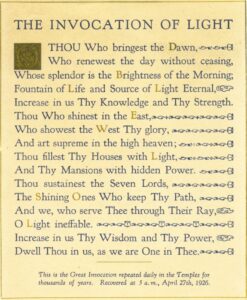
Part of the Work involved the preparation of the individual and the group to execute successfully the goal of the Masters and the Aquarian Foundation. This preparation involved mental work involving visualization exercises (“Monthly Instructions,” Instruction VI). The goal of engaging in the Work for the individual was to achieve the status of “perfected men and women, a perfected humanity—…to be achieved during the present Great Cycle.” an obvious reference to the status of Master (“An Elder Brother” 1970, Letter VI:95). This statement appears in the context of an exercise cited in this same Letter. The instructions or suggestions offered by Brother XII, are summarized as follows (“An Elder Brother” 1970, Letter VI:97–99): [Image at right]
Quiet the mind upon awakening.
Recite The Invocation of Light both verbally and mentally:
Devotion should be uppermost during the day: the lower self “shall do the Will of the Higher”:
Resolve not to do any unnecessary action;
Try to keep silence or at least do not speak necessarily;
“Pay attention to the body”:
“Read little, reflect much.” Maintain solitude, be cheerful and serene;
Close the day with a little reading and reflection, and repeat The Invocation of Light.
One final observation concerns the importance that Brother XII placed on Mabel Collins’ work, When the Sun Moves Northward, which investigates the significance of the sacred months of December through May and the mysteries of Life and Death. This work, as also Collins’s Light on the Path and Blavatsky’s The Voice of the Silence indicate that the “way of the Heart” is of special significance in acquiring a higher mode of consciousness, especially for this present Age (“An Elder Brother” 1970, Letter I: 16–17; III:47–50; IX 139–41; XI:170–77). Much of the work of the Aquarian Foundation was intended to impart spiritual truths (“An Elder Brother” 1970, Letter I: 112), some of which are in this book regarding the mysteries of human birth and death (“An Elder Brother” 1970, Letter III:49).
ORGANIZATION/LEADERSHIP
The Aquarian Foundation was incorporated by the government of British Columbia on May 16, 1927 and dissolved on November 1, 1929 by the same governing body. Because the Foundation was a legal entity, formal governance was required. In the case of the Foundation, seven governors directed its policies and actions. The seven original governors included Edward Arthur Wilson (Brother XII); Edward Lucas, a leading Vancouver attorney who advised Wilson on legal matters; Joseph Benner, author of The Impersonal Life and head of the Sun Publishing Company in Akron, Ohio, which distributed and printed many of Brother XII’s writings; Coulson Turnbull, a prominent American astrologer and author of The Solar Logos, among other highly regarded works; Will Levington Comfort, a well-known novelist and short story writer for The Saturday Evening Post; Maurice Von Platen, a wealthy retired Chicago manufacturer; and Phillip Jutson Fisher, the son of a wealthy family in Birmingham, England, and an early supporter of Brother XII’s work.
In 1928, the Mandieh Settlement was established on the newly acquired Valdes Island, which was founded as “a school for occult training” and a “Center of Safety” or “City of Refuge.” By 1929, the Mandieh Settlement was renamed the “Brothers’ Center” (Oliphant 2006:231), a community with higher level of spiritual training than the Aquarian Foundation, thereby far more challenging for candidates to be admitted. Unlike the Aquarian Foundation, the Brothers’ Center was never incorporated. Therefore Brother XII maintained complete control, later aided by Mabel Skottowe, who was for all practical purposes a co-leader, especially over the women of the colony.
In addition to this secular leadership, there was a “spiritual” hierarchy that extended from the Masters of the White Lodge, to chelas or disciples, aspirants, and ordinary but earnest followers (The Brother, XII 2012, Letter X:47). Chelas were divided into Accepted and Probationary disciples. An Accepted disciple is chosen by a Master, to whom he is under His supervision though not necessarily conscious of this fact. As an Accepted disciple, he becomes a member of the Great White Lodge or younger Brother of the Great Brotherhood (The Brother, XII 2012, “On Chêlaship:”91). An Accepted disciple may be either initiated or uninitiated. An uninitiated disciple is unaware of any connection with a Master. An awareness of such a connection would indicate that a Master is preparing him for the First Initiation. Once initiated, he attains the special status of Initiated Chêla (The Brother, XII 2012, “On Chêlaship:”92). This was the status of Brother XII, who also claimed to be a Messenger of the Master because of his claim for speaking on behalf of the Masters.
The Accepted chelas are especially important since the work so often mentioned by Brother XII includes the training of individuals (especially aspirants and probationary chelas) to achieve this status, since it is on this level that one becomes an “accepted member of the White Lodge,” a “younger Brother of the Great Brotherhood” (The Brother, XII 2012, “On Chêlaship”:91). Lastly, those who are accepted may fall under one of two categories: initiated (as was Brother XII) and those who are not initiated (The Brother, XII 2012, “On Chêlaship”:92). An uninitiated disciple is unaware of any connection with a Master. However, an awareness of such a connection would indicate that a Master is preparing him for the First Initiation. Once initiated, he attains the special status of Initiated Chêla (The Brother, XII 2012, “On Chêlaship”:92). This was the status of Brother XII, who also claimed to be a Messenger of the Master because of his claim for speaking on behalf of the Masters.
ISSUES/CHALLENGES
The Aquarian Foundation was a short-lived organization, having come to the attention of the public in 1926 and all vestiges of the colony dissolving in 1933. There is no doubt that the Foundation would have enjoyed many years of success due to Brother XII’s prophesy of events that bore a resemblance to the popular and contemporary expectation within the Theosophical Society of the imminent arrival of the World Teacher and the growing appearance of the sixth sub-race. Perhaps even more importantly was his ability to infuse a sense of urgency, preparation, and fear due to the transitional period of devastation and death followed by a new age of heightened consciousness culminating in the realization and practice of universal brotherhood by the successor sub-race. This message would surely have maintained a vibrant organization until, perhaps, those times when major events were forecast: 1975, with the appearance of the Messenger and dawn of the Age of Aquarius. Had these events failed to manifest by 1975, there can be on doubt that the Aquarian Foundation-Brothers’ Center would have been seriously weakened.
Its actual demise, however, was sparked by the actions and personality of Brother XII, who acted in a manner that was in total contradiction to how an accepted chela of the Master was expected to act.
IMAGES
Image #1: E. A. Wilson in a portrait with his sister Elsie (left). The date is sometimes in the late 1880’s.
Image #2: E. A. Wilson at age 47 in 1925 at the inception of his public work.
Image #3: The Governors of the Aquarian Foundation. From left to right: Edward Lucas (back to camera), Joseph Benner, Maurice Von Platen, E. A. Wilson (with hat), Phillip Fisher, Will Levington Comfort, and Coulson Turnbull. Photo taken during the first Annual General Meeting of the Aquarian Foundation on July 25, 1927.
Image #4: Map showing the areas of Brother XII’s activities, including Cedar-by-the-Sea, Valdes and the Mandieh Settlement, and DeCourcy Island.
Image #5: The Invocation of Light.
REFERENCES
Monthly Instructions [Twelve monthly “Outer Orders” written by Brother XII from September 1927 to October 1928]. Unpublished. Instructions I, IV, V, VIII.
The Three Truths: A Simple Statement of the Fundamental Philosophy of Life. As declared and shown to “Brother XII” (the personal Chêla of a Master).
“An Elder Brother” [E. A. Wilson], 1970. Unsigned Letters from an Elder Brother. Second edition. Montreal: Aura Press [Originally published by L. N. Fowler (London), 1930]. “The Brothers’ School”; Letter VI.
Blake, Sydney. 1939. “Connally vs. de Valdes,” The Lawyer 311, September:13.
Blavatsky, H. P. The Secret Doctrine. Volumes I and II. Los Angeles: The Theosophy Company, 1974 [Facsimile of the original edition 1888).
Collins, Mabel. 1923. When the Sun Moves Northward. Wheaton, Ill.: Theosophical Press.
Collins, Mabel. 1919. The Idyll of the White Lotus. Fourth Edition. Adyar, Madras: The Theosophical Publishing House.
Harrison, Victor B. “Brother XII Affair.” 2015. Interview transcribed by Jennifer Bolstler, Vancouver Island University. January 24, 2015) [Private collection, unpublished].
Oliphant, John. 2012. “Brother XII’s Early Years: The Letters of Edward Arthur Wilson.” Theosophical History XVI:29–64.
Oliphant, John. 2006. Brother XII: The Strange Odyssey of a 20th-Century Prophet and His Quest for a New World. Second edition. Halifax, Nova Scotia: Twelfth House Press.
Oliphant, John. 1993. “The Teachings of Brother XII.” Theosophical History IV:194–219.
The Brother, XII. 1928. The End of Days. Nanaimo, B. C.: The Chalice Press.
[The Brother, XII]. 1927. The Aquarian Foundation: A Movement for the Unification of All Men of Good Will. Akron, Ohio: Sun Publishing Co. (E. A. Wilson), 1927: General Letter No. 1., 1926.
The Brother, XII. 2012. Foundation Letters and Teachings. York Beach, ME: The Teitan Press [Originally published in 1927 by E. A. Wilson]. Cited sources: Letters I, II, III, IX, X, XI, XII, XIII, XIV, XVI, XVII. “On Chelaship”;“Concerning the Nature and Use of Higher Consciousness”; “The Message” (“A Message from the Masters of the Wisdom in 1926”); “The Shadow”; “The Significance of Earnestness: Part II: “The Tocsin”; “Things We Ought to Know”;
Publication Date:
18 February 2024

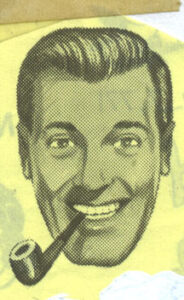
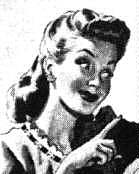 the Church’s appropriation of feminist ideology as part of its overall worldview (SubGenius Foundation 1983). [Image at right]
the Church’s appropriation of feminist ideology as part of its overall worldview (SubGenius Foundation 1983). [Image at right]
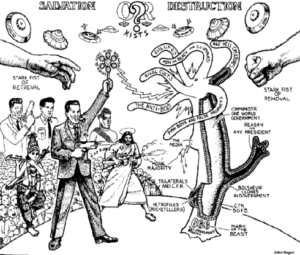
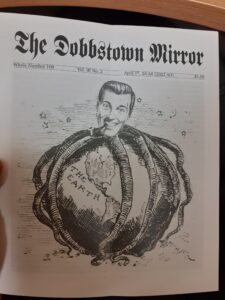
 Tenets, LifeSpirit, and Illumination (Bloomfield and Willes 2023). Genesis II was founded in January 2010 by Mark Grenon and Jim Humble. Mark Grenon was born in 1957 and, according to his own accounts, served as a missionary pilot in the Dominican Republic, Nigeria and Haiti for twenty-seven years. Jim Humble [Image at right] was born in Alabama and, according to his website, served in the Marines, worked for Aerospace and as a gold miner (Humble 2017). It appears that Humble also was a practitioner in the Church of Scientology for a time. According to Grenon, he and his eight children all contracted MRSA (Methicillin-resistant Staphylococcus aureus), a staph infection that he was unable to treat with antibiotics. In a state of concern, he searched the internet; in late 2006 found Jim Humble’s book, Miracle Mineral Supplements (MMS) and learned about the potential for curing diseases. MMS is a solution of sodium chlorite (22.4%) dissolved in distilled water. An acid like hydrochloride (HCL) is then added to the solution to produce sodium dioxide, an oxidating process. Grenon then treated his condition with Humble’s Miracle Mineral Solution, first himself and then the remainder of his family.
Tenets, LifeSpirit, and Illumination (Bloomfield and Willes 2023). Genesis II was founded in January 2010 by Mark Grenon and Jim Humble. Mark Grenon was born in 1957 and, according to his own accounts, served as a missionary pilot in the Dominican Republic, Nigeria and Haiti for twenty-seven years. Jim Humble [Image at right] was born in Alabama and, according to his website, served in the Marines, worked for Aerospace and as a gold miner (Humble 2017). It appears that Humble also was a practitioner in the Church of Scientology for a time. According to Grenon, he and his eight children all contracted MRSA (Methicillin-resistant Staphylococcus aureus), a staph infection that he was unable to treat with antibiotics. In a state of concern, he searched the internet; in late 2006 found Jim Humble’s book, Miracle Mineral Supplements (MMS) and learned about the potential for curing diseases. MMS is a solution of sodium chlorite (22.4%) dissolved in distilled water. An acid like hydrochloride (HCL) is then added to the solution to produce sodium dioxide, an oxidating process. Grenon then treated his condition with Humble’s Miracle Mineral Solution, first himself and then the remainder of his family.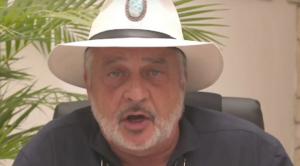
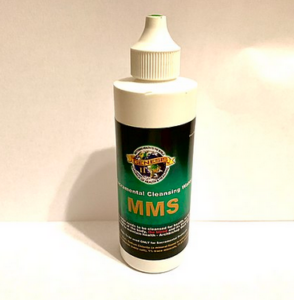
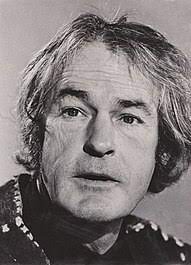 bohemian hippie community. They set up a store front called Mystic Arts World and sold various products that catered to the growing psychedelic subculture. It seemed that the Brotherhood and its gospel of love and LSD was gaining traction, but to grow even further, they would need legitimation of a grander sort. Griggs began to recruit of one of the most infamous counter-cultural icons of the 1960s,
bohemian hippie community. They set up a store front called Mystic Arts World and sold various products that catered to the growing psychedelic subculture. It seemed that the Brotherhood and its gospel of love and LSD was gaining traction, but to grow even further, they would need legitimation of a grander sort. Griggs began to recruit of one of the most infamous counter-cultural icons of the 1960s, 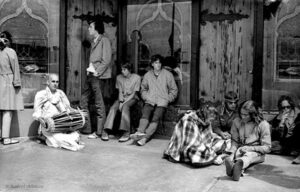 west coast. Leary, who was facing mounting law enforcement pressure in New York, would eventually move to Laguna Beach in 1966. In Laguna, Leary and his family took root, hosting psychedelic sessions and lectures at the Mystic Arts World on Leary’s popular catchphrase: “turn on, tune in, and drop out” (Greenfield 2006). [Image at right] Leary settled into his role as the spiritual guru, bringing both academic clout and a “pop-star” like presence to the west coast, and it certainly gave the Brotherhood a sense of visibility that they didn’t have before (Schou 2010). Griggs and Leary’s relationship was mutually beneficial as they worked together to hatch a plan to find a property that would help them and others to “drop out” of society, but they did have disagreements as to where. Griggs, and much of the Brotherhood, had always envisioned buying an island utopia somewhere in the South Pacific; Leary, on the other hand, wanted to stay on the mainland. Many members of the Brotherhood believed Leary wanted to stay on the mainland to be closer to media and publicity in order to take psychedelics mainstream. Eventually, the Brotherhood used their money to buy a ranch north of Palm Springs, and named it the Idyllwild ranch. The purchasing of the ranch foreshadowed the divergent views within the Brotherhood, as it became increasingly muddled by Leary’s fame, money from the drug trade, and the ambitions to transform society (Schou 2010).
west coast. Leary, who was facing mounting law enforcement pressure in New York, would eventually move to Laguna Beach in 1966. In Laguna, Leary and his family took root, hosting psychedelic sessions and lectures at the Mystic Arts World on Leary’s popular catchphrase: “turn on, tune in, and drop out” (Greenfield 2006). [Image at right] Leary settled into his role as the spiritual guru, bringing both academic clout and a “pop-star” like presence to the west coast, and it certainly gave the Brotherhood a sense of visibility that they didn’t have before (Schou 2010). Griggs and Leary’s relationship was mutually beneficial as they worked together to hatch a plan to find a property that would help them and others to “drop out” of society, but they did have disagreements as to where. Griggs, and much of the Brotherhood, had always envisioned buying an island utopia somewhere in the South Pacific; Leary, on the other hand, wanted to stay on the mainland. Many members of the Brotherhood believed Leary wanted to stay on the mainland to be closer to media and publicity in order to take psychedelics mainstream. Eventually, the Brotherhood used their money to buy a ranch north of Palm Springs, and named it the Idyllwild ranch. The purchasing of the ranch foreshadowed the divergent views within the Brotherhood, as it became increasingly muddled by Leary’s fame, money from the drug trade, and the ambitions to transform society (Schou 2010).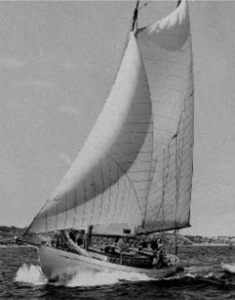 opportunity to build the island utopia. Hawaii had transformed into a haven for hippies, surfers, and various vagabonds, all of whom had an insatiable appetite for marijuana. To capitalize on this large market, Ashbrook purchased a seventy-foot yacht, the Aafje, to smuggle hash from Asia and Mexico into Maui. [Image at right] From 1969-1972, Maui was indeed profitable, as many members of the Brotherhood raked in hundreds of thousands, if not millions, in illicit drug profits (Maguire and Ritter 2014).
opportunity to build the island utopia. Hawaii had transformed into a haven for hippies, surfers, and various vagabonds, all of whom had an insatiable appetite for marijuana. To capitalize on this large market, Ashbrook purchased a seventy-foot yacht, the Aafje, to smuggle hash from Asia and Mexico into Maui. [Image at right] From 1969-1972, Maui was indeed profitable, as many members of the Brotherhood raked in hundreds of thousands, if not millions, in illicit drug profits (Maguire and Ritter 2014).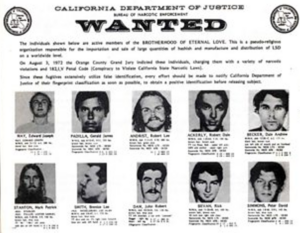 continued through the following year. Twenty-six members of the Brotherhood, or those affiliated with its smuggling operation, were targeted by police. [Image at right] Possibly the biggest catch, Timothy Leary, was captured in Kabul, Afghanistan, and flown back to Los Angeles. He was charged with escaping prison, along with various other drug charges. The police raid, and the revelations of the depths of the drug trafficking operations, no doubt captured the media’s attention, with Rolling Stone magazine dubbing the group “the Hippie Mafia.” By October 3, 1973, the U.S. government all but celebrated its victory over the Brotherhood. That day, a subcommittee hearing, entitled “Hashish Smuggling and Passport Fraud: The Brotherhood of Eternal Love,” highlighted the extensive drug smuggling operation of the group. DEA supervisor Job Sinclair told Congress:
continued through the following year. Twenty-six members of the Brotherhood, or those affiliated with its smuggling operation, were targeted by police. [Image at right] Possibly the biggest catch, Timothy Leary, was captured in Kabul, Afghanistan, and flown back to Los Angeles. He was charged with escaping prison, along with various other drug charges. The police raid, and the revelations of the depths of the drug trafficking operations, no doubt captured the media’s attention, with Rolling Stone magazine dubbing the group “the Hippie Mafia.” By October 3, 1973, the U.S. government all but celebrated its victory over the Brotherhood. That day, a subcommittee hearing, entitled “Hashish Smuggling and Passport Fraud: The Brotherhood of Eternal Love,” highlighted the extensive drug smuggling operation of the group. DEA supervisor Job Sinclair told Congress: